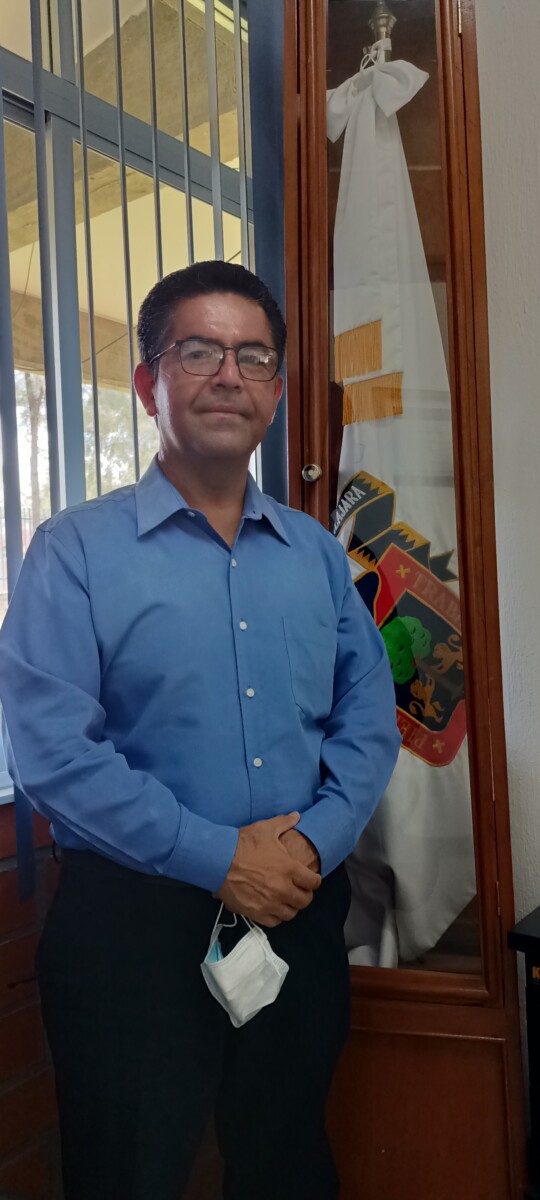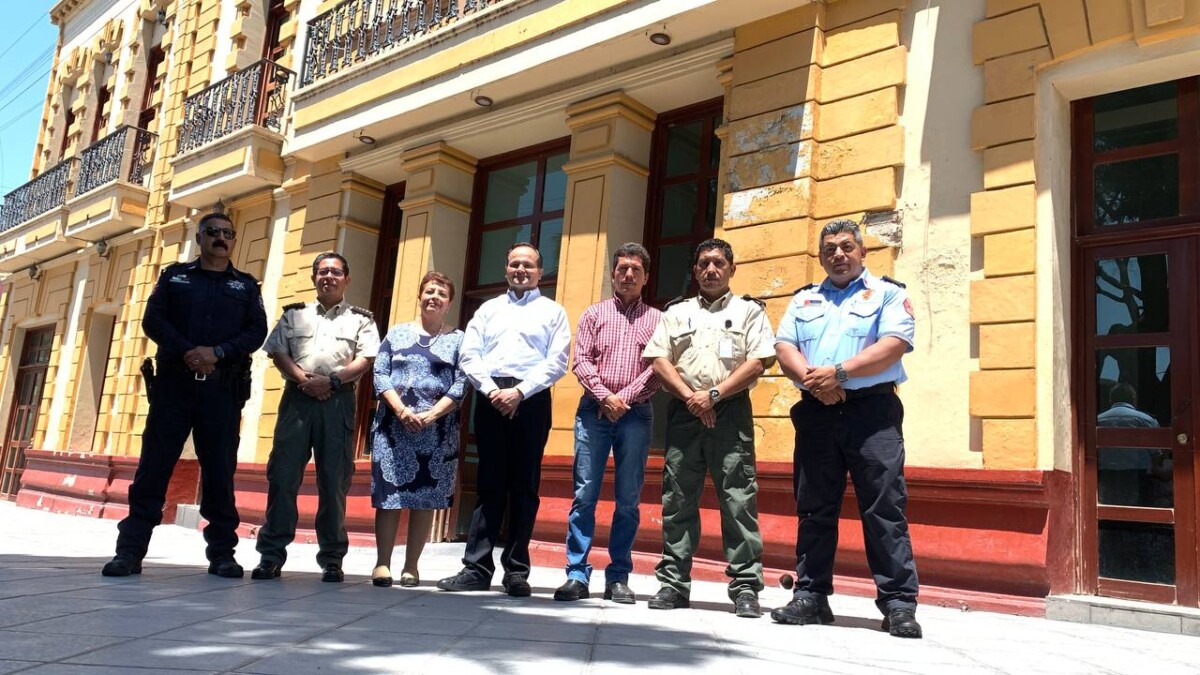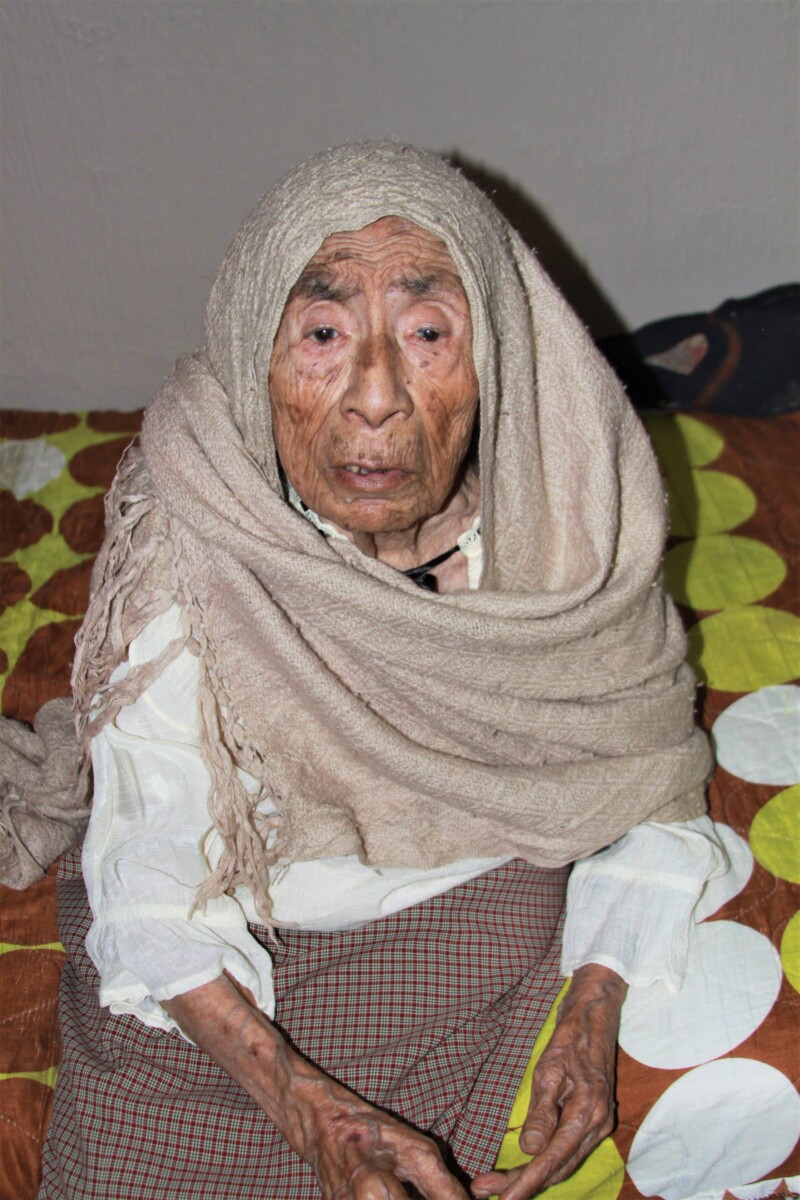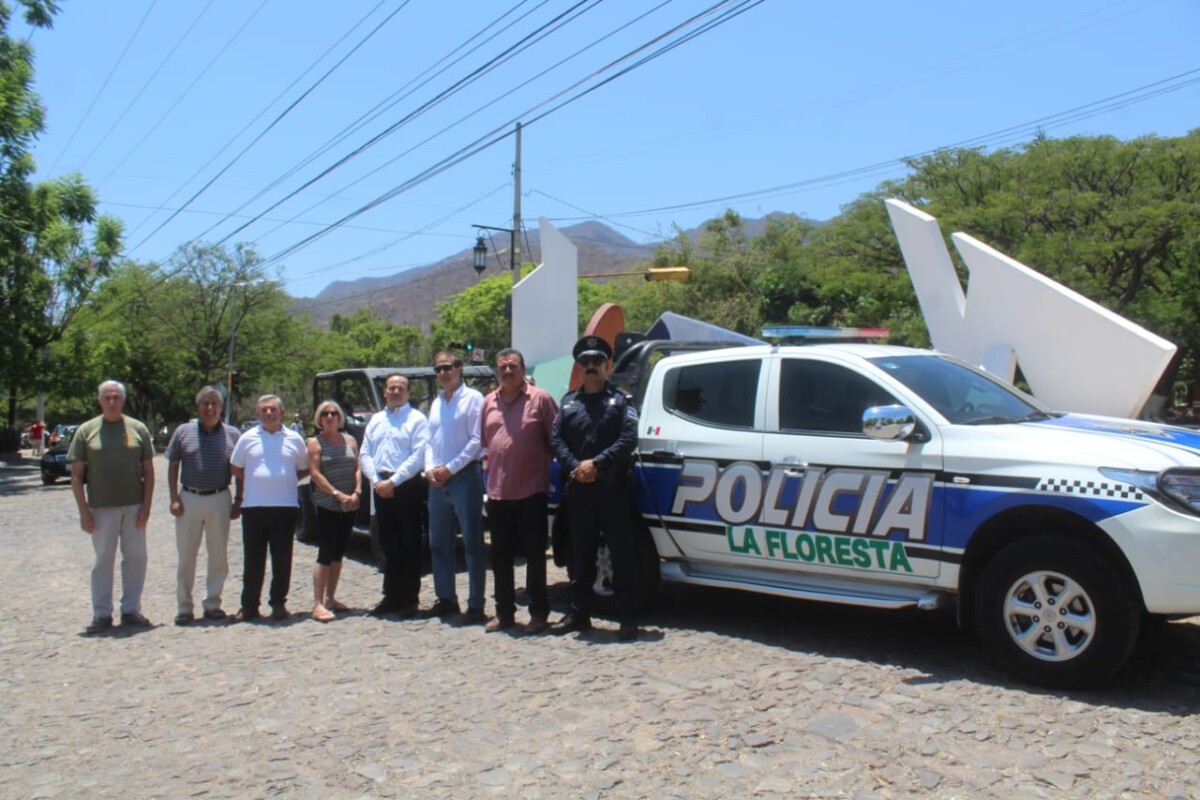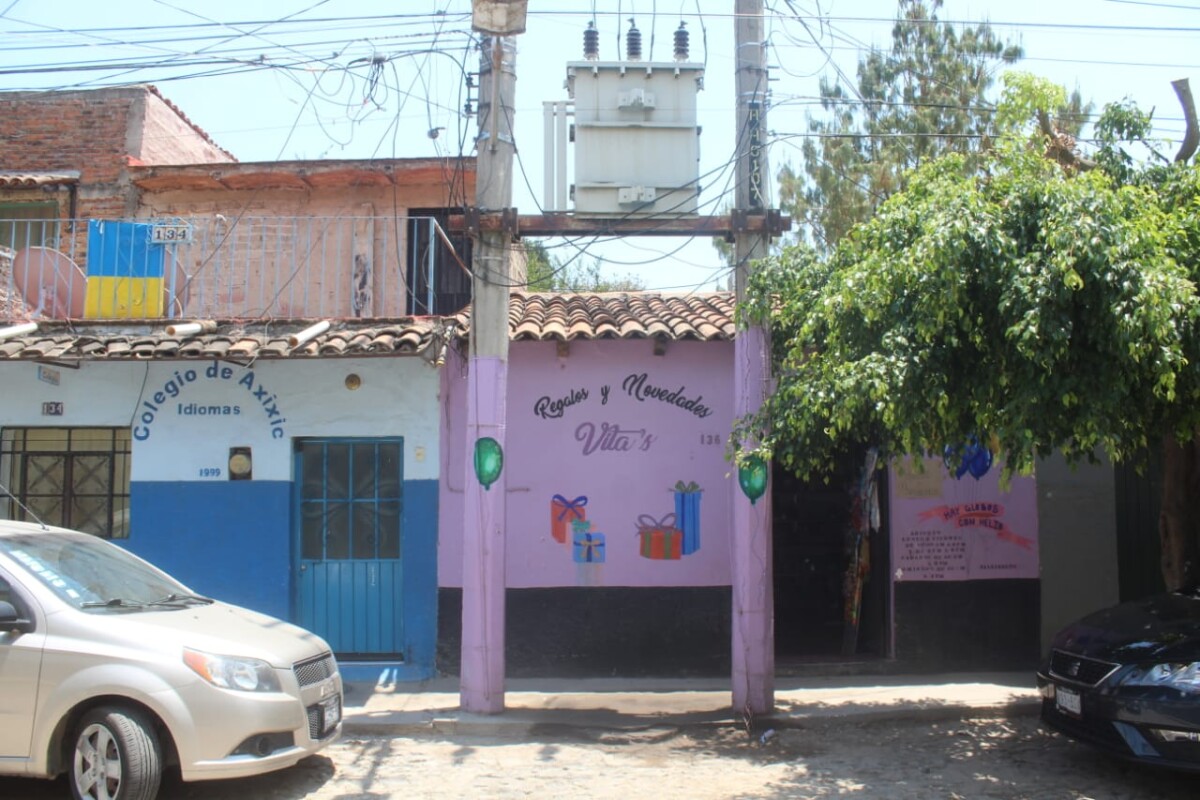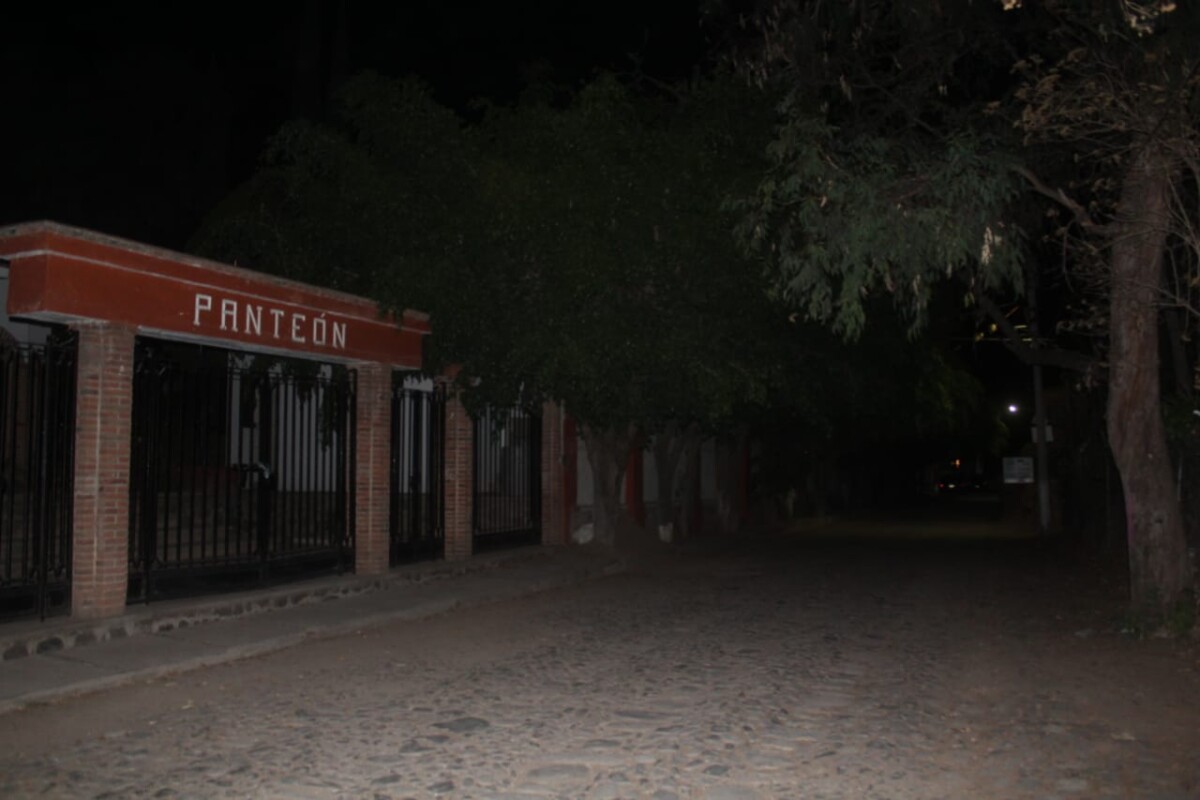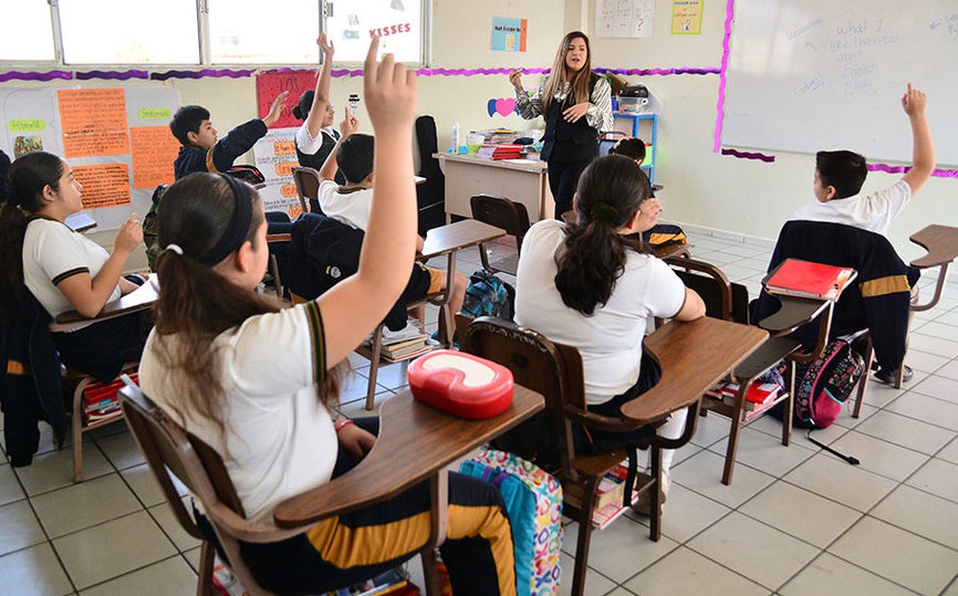gente
New Chapala high school director targets sexual abuse and bullying
Fernando Riveros Magaña, director of the Chapala Regional High School. Photo: Jazmin Stengel.
Jazmín Stengel (Chapala).- Sex education, and keeping students safe from harassment and bullying will be a priority for Fernando Riveros Magaña, the new director at the head of the Chapala Regional High School of the University of Guadalajara (UdeG), for the period 2022-2025.
Riveros Magaña served as Secretary General of the Chapala school from 2015 to 2018. Now, he takes the place of his colleague and friend Juan Ramón Álvarez López, who led the high school management since 2015.
Riveros Magaña says his priority will be to train teachers to raise awareness and diagnose disorders that may cause harm to students.
He said that a case of alleged sexual harassment involving Professor David N. is unique in the Chapala High School record to date.
«Teachers must not only conscientiously avoid the abuse of minors,» he said, but they must act as first responders in situations of bullying or harassment.
«Harassment is something deeply rooted at all levels,” Riveros Magaña told Laguna. “However, that does not justify it happening here,» he said.
Students will be taught to recognize different levels of bullying and harassment and urged to report such incidents to the proper authorities if they themselves are victims. This would help create a safety net between teachers, administrators and students.
Issues relating to gender violence and sexual diversity would also be addressed, from the point of view of both young people and adults.
“The staff must be open to new forms of expression of love and coexistence between couples,” as well as being respectful towards, and tolerant of, the LGBTQ+ community, said Riveros Magaña.
The new director said he was aware of the need for more psychologists to serve students. His ideal is to have at least one psychologist per shift, with help from teachers who are knowledgeable about the subject.
Riveros Magaña said he would also work to resolve infrastructure deficiencies at the school, including drainage repairs at bathrooms, which must be fixed before they become a hygiene problem.
The director also plans to create a wired internet network with fewer bugs and powered by solar panels. His most ambitious project is a large, open-air auditorium where young people can engage in activities in combination with the cultural centers of the municipality.
Fernando Riveros Magaña, 56 years old, graduated from the Faculty of Medicine of the University of Guadalajara in 1993. For 13 years he worked as a private doctor in the system of the Federal Health Secretariat, currently serving for the Jocotepec Community Hospital.
His teaching career began 13 years ago at the University Center of the North (CUNorte) of the UdeG in Colotlán. He also was in charge of Medical Services at the Los Valles University and area manager at the Universidad de Oriente. Within the UdeG he is responsible for the Outreach and Liaison Area of the Transdisciplinary Literacy Institute (ITRALI) and deputy director of the “Letras a Volar” («Letters to Fly») program.
Translated by Alan Ferguson
Diversion of streams by real estate developers to blame for last year’s landslides
The mayor of Chapala, Alejandro de Jesús Aguirre Curiel, accompanied by municipal officials and elements of Civil Protection and Chapala Firefighters.
Editorial Staff.- Real estate developers who improperly diverted streams were largely to blame for major landslides in Chapala riverbeds last October, an investigation has confirmed.
The results of a diagnosis by the State Civil Protection Unit of the State of Jalisco (UEPCBJ) showed that the diversions had greatly reduced the natural width of the channels.
The diagnosis was revealed during a session of the Municipal Council of Civil Protection of the Municipality on Thursday, May 19.
State director Roldán Guerrero said the narrowing of the channels threatened the sustainability of the fragile micro-basin in the municipality. He argued against any type of construction that puts the population at risk.
The municipal president of Chapala, Alejandro de Jesús Aguirre Curiel, said that since his administration began, no real estate development had been approved.
He added that collaboration between all parties involved in future developments would be of the utmost importance to guarantee the security of residents.
The director of Civil Protection and Firefighters of Chapala, Lorenzo Antonio Salazar, reported that maintenance and conservation of riverbeds in federal zones had begun.
He said the work consists of cleaning streams in the municipality, starting in the Ajijic delegation since that was where the greater number of obstructions in the channels was detected.
He said that 30 percent of the work had been done, using machinery from the municipality and involving personnel from Public Works, General Services, Public Cleaning and Parks and Gardens.
The municipal director cited a previous lack of maintenance as a problem, with channels becoming obstructed by branches, trunks, earth and stones.
The rainy and tropical cyclone season began on May 15 and is expected to end on November 30.
Translated by Alan Ferguson
Convoca UdeG a megamarcha por los recortes presupuestales del Gobierno de Jalisco
Se espera que en la megamarcha del 26 de mayo se movilicen más de 70 mil personas, entre estudiantes, directivos y docentes de la UdeG. Foto: Gaceta UdeG.
Redacción.- La Universidad de Guadalajara (UdeG) convocó a una mega movilización el próximo jueves 26 de mayo en Guadalajara, en favor de un presupuesto digno y el respeto a la autonomía universitaria.
Durante la marcha 93, realizada el pasado 17 de mayo, el Rector General de la UdeG, Ricardo Villanueva Lomelí, exigió la restitución de los 140 millones de pesos que el gobernador Enrique Alfaro Ramírez recortó a la máxima casa de estudios de Jalisco.
Por tal motivo, Villanueva Lomelí convocó a la comunidad universitaria y a los jaliscienses a sumarse a la marcha más grande de la historia del estado para defender a la universidad.
“Yo quiero invitarlos el día de hoy a que el 26 de mayo hagamos la marcha más grande en la historia de Jalisco, porque esta es la ilegalidad y el atropello más grande en la historia de la Universidad”, declaró.
De acuerdo a cálculos de Javier Armenta, presidente de la Federación de Estudiantes Universitarios (FEU), se espera que más de 70 mil estudiantes, además de los directivos, personal docente y administrativo, se manifiesten este jueves para exigir más recursos para la Universidad.
De cara a la megamarcha, la tensión entre la Universidad de Guadalajara y el Gobierno de Jalisco aumentó debido a que el 23 de mayo un grupo de alrededor de 70 personas enmascaradas protestaron afuera del fraccionamiento donde vive el rector general, Ricardo Villanueva, para denunciar la presunta presión de parte de los maestros hacia los alumnos para que marchen el 27 de de mayo.
Al respecto, el rector atribuyó la protesta como una “campaña sucia” del Gobierno de Jalisco para debilitar la convocatoria a la mega marcha, asimismo, señaló al gobernador Enrique Alfaro como el responsable de su seguridad y la de su familia.
Por su parte, el mandatario estatal se deslindó de la manifestación en el fraccionamiento Las Cañadas de Zapopan, al argumentar que se encuentra “ocupado” trabajando por Jalisco y no en organizar marchas.
“Yo estoy concentrado trabajando por Jalisco. Yo no me voy a distraer en temas que no me tocan. Quien quiera dedicarse a organizar marchas, que lo haga bajo su responsabilidad”.
En el boletín difundido por la UdeG, fue en agosto de 2021 cuando, de manera arbitraria, el Gobierno de Jalisco hizo un recorte 140 millones de pesos que ya habían sido autorizados para la construcción del Museo de Ciencias Ambientales, además de que el presupuesto aprobado en 2022, es el más bajo de los últimos 10 años.
Por esta situación, la Universidad presentó una controversia constitucional ante la Comisión Estatal de Derechos Humanos (CEDHJ) por la reasignación del presupuesto; sin embargo, la Suprema Corte de Justicia de la Nación (SCJN) desechó la controversia a finales de marzo pasado.
Por su parte, tras la resolución de la SCJN, el Gobernador de Jalisco, Enrique Alfaro Ramírez, declaró mediante sus redes sociales el apoyo a la UdeG, pero no así al “grupo que la controla”.
“Hace unos momentos la Suprema Corte de Justicia de la Nación volvió a poner la verdad por encima de las mentiras. A la Universidad de Guadalajara nuestro apoyo, cariño y compromiso, pero no a los negocios del grupo que la controla”.
Asimismo, el mandatario estatal comentó que el dinero recortado será destinado a la construcción del Hospital Civil de Oriente o el Hospital Civil de Tonalá.
Lakeside Chronicles:
At 89 years old, Dominga Larios, the operator of the first telephone line in San Cristóbal Zapotitlán, keeps alive the memories of her great challenge.
By: María del Refugio Reynozo Medina
The women of her day were mostly dedicated to washing and ironing the clothes of the men of the house; also to cooking. «Sometimes I would finish a load of firewood in one of my dad’s and my brothers’ ironing.» In those days when there was no electricity in San Cristóbal Zapotitlán, the irons were made of iron and heated by fire.
Dominga Larios Díaz not only faced loads of clothes to wash and iron; she also defied her fears and became the first woman to operate the first telephone line in town, to establish communication with the outside world.
It was the priest Pedro Rivera Chávez who entrusted her with this responsibility and told her, “I have talked to the people in Mexico and yes, they are going to bring us the telephone.»
Dominga was afraid, but she knew that she had to obey the priest’s wishes.
“You are not going to have ears,» said the parish priest. Referring to the necessary discretion in having access to other people’s conversations.
«Letters are closed, telegrams too, but the telephone is a living thing, be very careful with your mouth.»
Father Pedro told her that he had received an offer to place it in Carmen Mosqueda’s store, but he did not want to because many people came and went to the store, and it would be difficult to maintain communication with the necessary privacy.
Minga, as she was affectionately called, was chosen to guard the telephone booth that would allow San Cristobal to communicate with the world. The arrival of this communication network placed the town on the stage along with many towns in Jalisco.
Her responsibility, besides sending and receiving the messages, consisted of going to the homes to let them know they had a call and traveling to Tizapán every month to deliver the reports and the money for the operations carried out to an office.
“I had never left town before then, but I would walk to the crossroads to wait for the bus that would take me to Tizapán.»
Everything was new to her; the operation of the network, the writing of the reports and the necessary trips out of the community where she had always stayed. In the office she met with the operators of other communication booths, they were all men.
She remembers when there was an inauguration; that day, many important people from Guadalajara and Mexico City came to San Cristóbal, and there was much jubilation in the town.
Although Dominga did not have a fixed salary, only what she could be given on a monthly basis, she always kept in mind Father Rivera’s command, mouth shut and ears absent. Even when on one occasion a groom from the United States communicated with the bride from San Cristóbal and in the middle of the wedding the other groom from San Cristóbal appeared on the scene. Minga had to hide the bride in the phone booth.
Deep in her memories, Dominga remembers the booth, it was a wooden structure where one person could fit, inside was the device with keys and a crank to make the dials.
Some people remember that she used to wind it up, while she would say okay, okay. She would call a switchboard so that from there she would be connected to the number she requested. The telephone was made of metal, big and heavy. The ringing of the phone was so loud that it could be heard all the way to the school that was almost a block away from her house.
The room where the phone booth was located was always clean, there was a large wooden bench, and around it were pots of green leaves.
-Jocotepec-
He repeatedly pronounced, to call the addressees.
-San Miguel Cuyutlán.
-Guadalajara-
Dominga’s house not only housed the first communication system; it was also the cradle of musicians. Her father Justino Larios, a town musician who learned to play more than three instruments, thanks to a priest from San Juan Cosalá, founded a band of more than twenty members. The students were very young, some children and teenagers, they even fell asleep at the end of the class, at night and thus asleep, Justino took them to his home. The largest room of the Larios’ house became a party after every rehearsal night, where the stage was set to music with waltzes and paso-doble dances. Musicians Silviano Reynoso and Martín Reynoso were his disciples.
Justino was also the teacher of his sons Fermín and Heriberto Larios. Heriberto, was almost a child when Justino was asked to be a trombonist, at the age of eleven, Heriberto was already playing trombone and clarinet. His father sent him with the musicians for the novenario 9-day religious event in Tala, Jalisco.
“They are taking my boy,» his mother would exclaim, preparing his clothes for the stay. As the days went by, she wondered, «How is my boy doing?”
Upon her return, Dominga recalls that Heriberto arrived bringing her mother a birote, a bread roll, from the plant.
“What a beautiful son,» said Petra with emotion. With the memory of that scene, Minga shed a tear.
In the midst of a sea of emotions, Dominga continues telling her story.
“Will you invite me to sit next to you?» I said to say goodbye.
“Will you buy me a drink or shall I buy you a drink,» she says smiling before I sit next to her on the edge of the bed.
At 89 years old, Minga lives from her memories in her neat bedroom accompanied by prayer books; the discreet operator who learned to forget names but to remember the stories that wove her youthful days.
Translated by Kerry Watson
Residents of La Floresta loan patrol car to Chapala
The patrol car was transferred on May 19. Photo: Sofía Medeles.
Sofía Medeles (Ajijic).- A patrol unit was given on loan to the Government of Chapala by the residents of La Floresta. They were responsible for acquiring the vehicle for the use and care of the subdivision and nearby areas.
The car is labeled with the logos of the municipal police and the subdivision. The neighborhood association president, Fernando Plata, said that the car cost more than 400 thousand pesos (about US$20,000). The car was paid for by residents of La Floresta.

The moment when the neighborhood association president, Fernando Plata, handed the key to the municipal president, Alejandro Aguirre. Photo: Sofía Medeles.
Plata also pointed out that the municipal government provides the officers who will carry out the patrol work in the area and the surrounding streets. In case of emergencies, the car can be used in other parts of the municipality.
During the meeting held on May 19, Fernando Plata spoke with the municipal president, Alejandro Aguirre Curiel, about upcoming projects to improve the flow of traffic on the highway and pedestrian circulation in the area.
The formal handover ceremony, which took place at the La Floresta sculpture on the Chapala-Jocotepec highway, was also attended by acting Ajijic delegate Maximiano Macias Arceo, Sergio Conzuelo Ramirez, commander of the municipal police, and members of the board of directors of the subdivision.
CFE continues to ignore reports of damaged transformer in Ajijic
Transformer that has not been repaired after a fire. It is located near the intersection of Ocampo and Francisco Villa. Photo: Sofía Medeles.
Sofía Medeles (Ajijic).- A transformer in Ajijic has been out of order for more than a month, and repairs have not been performed by the Federal Electricity Commission (CFE), despite multiple reports made by the town, neighbors, and the Chapala Directorate of Ecology.
On April 11, a fire in an electrical transformer located near the intersection of Francisco Villa and Ocampo streets was reported by nearby residents. The fire was extinguished; however, at the time of this writing, the transformer is still leaking oil.
More than 40 days later, those reports have not been addressed and the damage is still evident. Witnesses have commented that despite complaints, CFE does not provide any information other than the transformer will soon be attended to.

Since the incident, oil has been leaking and leaving a stain under the transformer. Photo: Sofia Medeles.
Ajijic acting delegate Maximiano Macias Arceo commented that he considers the oil spill to be a risk since he asserted that the oil is toxic and could cause burns if it comes into contact with the skin of passers-by.
«We have made countless reports and they have not attended [to repairs], we have even sent photos to the director of Ecology, and they have not attended the report either; we have not found the agency responsive to the danger and the need to get the transformer fixed,» Arceo pointed out.
Some of the neighbors interviewed in that area state that the device has stopped leaking oil, but even so, they have not reported it. «We have only been without internet, but never electricity, this failure has not affected us in that aspect,» said Andrés.
«It’s not that it doesn’t pump oil, but that it pumps very little. That scares some of us, because if it runs out of oil and overheats, it could cause a serious incident. Let’s see if they hurry before the worst happens, and God forbid, there are fatal accidents,» said Gloria.
Translated by MaryAnne Marble
Ajijic cemetery closing at night to prevent crime
Sofía Medeles (Ajijic).- In the last few weeks the doors of the Ajijic municipal cemetery have been closing before 10:00 p.m. due to the illicit activities that take place after nightfall.
Acting Ajijic delegateMaximiano Macias Arceo commented that this is an initiative that has been carried out throughout the municipality in an effort to prevent crime in these spaces. In this case to prevent garbage dumping and other misdeeds.
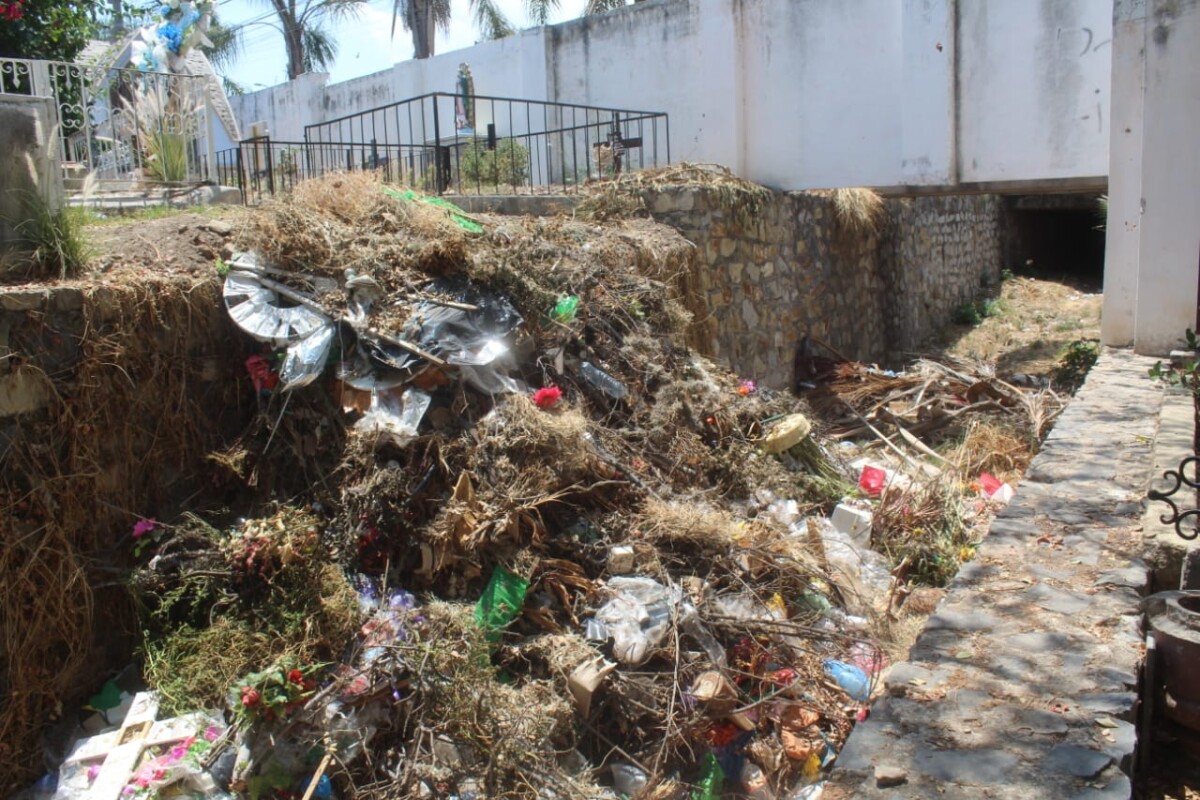
All kinds of garbage and debris in the creek that crosses the cemetery. Photo: Sofía Medeles.
«It is because of littering, and other acts like the vandalization of tombs, the theft of articles from the tombs and other inappropriate activities. All this used to happen at night, that is why this decision was made,» said Macías Arceo.
Macías Arceo said he was aware of customs in Ajijic, so if a family needs permission to start digging a grave during the night or to dig a grave, they can contact him to talk to the caretaker at 331-537-9134.
He also said that even though he has been contacted by people who are upset by this new decision, he believes it is the best way to reduce the dumping of waste in the creek that crosses the cemetery since, he pointed out, garbage has been dumped through the side entrances.
Finally, he made a call to the conscience of Ajijic residents to improve their habits regarding waste.
«We are not children; we do not need to be herded and told to do things. We need to have a culture of cleanliness, both in the cemetery and in Ajijic. This is a very present problem,» he concluded.
Translated by Sydney Metrick
Schedule
First International Theater Festival of Jocotepec 2022
Day: April 27 to May 31
Information at Casa de Cultura «José Vaca Flores»
Location: Hidalgo Sur #38, Jocotepec, downtown
Information at 387-763-1621
Course «Literature of Mexican Women Writers»
Day: April 28, May 5, 12, 19 and 26
Virtual literary course, taught by Charlotte Carranza
Place: Virtual course
Schedule: 6-8pm
Cost: Information at 331-273-1110

Mr Q
Day: Thursday June 2
Classic Rock Concert
Place: 4to Sentido, Carretera Chapala – Ajijic 89, Top Floor, Plaza Paradise Center, San Antonio
Schedule: 5pm
Cost: $250 pesos in advance and $250 pesos on site
16th Anniversary Son de Mexico International invites to the Gala Function
Day: May 21
Children’s Folkloric Ballet
Venue: Atrium of the old temple El Hospitalito, San Juan Cosalá, Centro Histórico
Time: 8pm
Limited seating
Xapawiyemeta
Day: Saturday May 21
Offering and traditional wake
Place: Isla de los Alacranes, Chapala
Schedule: 8pm
Information and registration at 331-286-7352

Huichol Art Festival
Day: Saturday May 21
Art, culture and traditional medicine
Place: Pablola Gallery, 16 de Septiembre #1 Ajijic, Downtown
Hours: 11am – 5pm
Translated by Christalle Dalsted
Ajijic jazz quartet to record a live concert in Guadalajara’s historic Teatro Maria Teresa
Triálogo Jazz Quartet. Eleazar Soto, Miguel Soto, Gilberto Ríos, and Sofía Ramirez. Photo credit: La Cochera Cultural.
Patrick O’Heffernan (Ajijic).- Guadalajara’s historic Teatro Maria Theresa will resonate with world class jazz as Ajijic’s renowned jazz quartet Triálogo records a live performance in a double-bill concert with jazz master Luis Shatter. The live recording will be produced as Triálogo’s debut album.
Triálogo is composed of Sofía Ramírez on piano and vocals, Gilberto Ríos on double bass and electric bass, Miguel Soto on drum, and Eleazar Soto on saxophone. The live recording and album production is underwritten by Ajijic’s La Cochera Cultural and local investors.

Luis Shatter. Photo credit: La Cochera Cultural.
Triálogo is well known in Lakeside for its very high level of talent and its constant search for innovation that results in music that is often exploratory. Each of the four members of Triálogo comes with a different background, including traditional jazz, free jazz, classical music, contemporary music, Afro-American rhythms, electronic rhythms, flamenco, and Latin rhythms.
They bring these influences together in their passion for jazz and for composing original songs, one reason they are beloved by Lakeside jazz fans along with world-class musicianship, a diverse catalog of songs, and their knack for engaging an audience.
Keyboardist and composer Luis Shatter will join Triálogo on the bill at Teatro Maria Theresa, joined by Marcos Díaz on saxophone; Juan Manuel Ayala on electric bass, and Armando Curiel on drums. Shatter e received a nomination for the 2022 Minerva’s de Jalisco Awards in the Best Jazz Artist category.
Shatter, who has collaborated and recorded with artists such as Hela San, La Celestina, Sharif, and Astrid Cruz, has released several singles and a live recorded EP titled Wabi-Sabi and his latest instrumental Petricor.
The public is welcome to the concert which begins at 8 pm at Teatro Maria Teresa, Calle Cruz Verde 121 between Independencia and Juan Manuel, downtown Guadalajara. Admission: $160 in presale / $200 the day of the event. Tickets on sale: teatromariateresa.com
Information: 33 19 79 01 96 / 33 11 90 88 963312879814 (S3 3312879814 (Sin central Guadalajara).
Día del Estudiante: cuenta Jalisco con más de 2 millones de alumnos
El nivel educativo con mayor matrícula es la primaria con el 41.0%, es decir, 933 mil 40 alumnos y alumnas. Foto: Cortesía.
Redacción.- En el marco de la conmemoración del Día del Estudiante, el Instituto de Información Geográfica y Estadística de Jalisco (IIEG), presentó un diagnóstico sobre la cantidad de alumnos en activo en el ciclo escolar 2021-2022.
Según dichas cifras, en el estado hay 2 millones 279 mil 231 alumnos y alumnas en las 15 mil 015 escuelas; 373 mil 240 (16.4%) se encuentran matriculados en instituciones particulares y 1 millón 905 mil 991 (83.6%) en escuelas públicas.
De la matrícula mencionada, el 41.0% (933,40) de las y los estudiantes se concentran en el nivel de primaria, seguido de un 18.3% (416,478) que se encuentra cursando la secundaria y de un 14.0% (319,518) que estudia en el nivel medio superior (modalidad escolarizada y mixta).
Asimismo, el 12.5% (285,423) pertenece al nivel superior, el 12.4% (281,773) al nivel de preescolar y 0.6% (14,020) a educación inicial; por su parte, el 1.3% (28,618) de las alumnas y alumnos son de educación especial.
El origen de celebrar el Día del Estudiante en México surge en 1929, cuando un grupo de estudiantes de la Universidad Nacional Autónoma de México (UNAM) se puso en huelga en favor de la autonomía universitaria.
© 2016. Todos los derechos reservados. Semanario de la Ribera de Chapala
